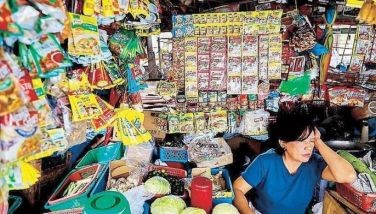Reforming labor policies

In a series of columns, I devoted space to labor and employment problems in the country. A major challenge for development policy is to provide more jobs, especially to the poor and the young entrants to the labor force.
“Quality jobs in industry and in agriculture, a must.†Job creation in the country is a festering problem, and it needs to move at a faster pace. The escape from poverty begins with a good job.
The Yolanda disaster has further aggravated the country’s poverty problem. A sustained response to the economic rehabilitation process in this region requires the assistance of new job-creating centers that absorb the available labor force into useful, productive and long term jobs.
To dramatize the solution that will be offered, I will cite a new development in the East Asian region that features structural changes happening in China that influence the international specialization in labor-using goods.
“Japan’s transfer of labor-intensive investments toward Southeast Asia.†Let me simply first quote an article datelined Tokyo on Dec. 5, 2013 to make an emphasis (by Shinohara Hideki of Nikkei):
‘Indonesia overtaking China as hotspot for Japanese apparel firms’
TOKYO – Japanese companies are ramping up textile and apparel production in Indonesia, a trend that is making the country a principal alternative to China as a location for conducting such operations.
Lower labor costs – a quarter of those in China -- are not the only attraction. Indonesia offers much better roads, ports and power supply infrastructure than Myanmar and Bangladesh, countries that are also drawing attention as manufacturing bases. In 2012, Indonesia accounted for just three percent of Japan’s imports of textile products, far lower than China’s 74 percent.
Trading house Mitsubishi will invest ¥6 billion ($57.9 million) to build seven joint venture factories in central Java by 2016 for OEM (original equipment manufacturer) supply to Japanese and Western apparel makers. Currently, about 70 percent of the company’s clothing output is concentrated in China -- where it consigns manufacturing operations to local businesses.
With labor costs rising sharply in China, Mitsubishi plans to transform Indonesia into a core production base. Four factories are scheduled to come onstream in 2014 to make outerwear and pants, among other items.
Nisshinbo will spend ¥3 billion to ¥4-billion to automate and expand manufacturing facilities at an existing textile and sewing factory in Indonesia. It will start out by installing state-of-the-art machines for making wrinkle-free shirts.
The factory currently produces enough cloth to make 19 million shirts a year. Most of its products are exported to Japan, but the market will be expanded to Europe starting in fall 2014. Nisshinbo will invest an additional ¥2 billion-to ¥3 billion as early as fiscal 2015 to boost output capacity by 10-20 percent. (end of quote)
Though this article is about Japan’s response to China’s structural change, it could apply to the global textile and apparel market, specifically those in the United States, Europe, and high income countries.
Moreover, the implication of the article is on the textile and apparel industry, it is as important to other industries that rely on more labor. It can include all high labor-using industries such as shoe-making, wood- and metal-working, household furniture, kitchenware products and agricultural processing.
‘Main challenge for labor policy.’ The main challenge for labor policy is to protect labor and to expand the opportunities for good jobs for all laborers.
Many workers have been excluded from gainful occupations because of high minimum wage policies. The goal, therefore, is to get some of these jobs back so that we can solve our own labor surplus problem.
Labor policies that have been built over many decades cannot be changed overnight. In fact, it is possible to think of reforms that we introduce to be mainly confined to specific regions where the largest degree of poverty and unemployment appears to be rampant.
What would be needed is a special mechanism to enable the country to expand job opportunities that are much in demand by global industries for as long as we have a large labor surplus. To get this done, we can work out some features of labor policy to enable enterprises – including the attraction of foreign direct investments – to hire labor with greater flexibility and to provide a venue for these firms to link the wages they pay with worker productivity.
In crafting any reform labor policies, it is essential that certain existing labor policies need to continue to assure that labor is protected. Social security and workmen’s compensation laws, the provision of other saving features while at work, including the fund for housing (the Pag-Ibig contributions), eight-hour work-day, overtime pay, and the provision for holidays are among these important anchors for labor protection.
‘The labor employment zone concept.’ The solution I propose is the “labor employment zones†described in earlier work on the subject. They would play the role of expanding labor absorption into new industrial and agricultural ventures, employing much larger sets of workers than is now found in the country.
The labor employment zone is similar in concept to the export processing zone concept which has been very successful in raising the country’s capacity to export despite the highly protective domestic industrial policy. Its main ingredient or incentive is that firms located in the labor employment zones are exempt from the minimum wage setting process. Wage determination will be mixed with liberal measures of productivity incentives so workers can improve their earnings.
Such employment zones can be put up in relatively poorer regions of the country. Specifically, such areas could include some designated sites in the Bicol region, in sites within eastern, central and western Visayas provinces.
The concept also has attractive possibilities for other regions where the population is mired in poverty. For instance, it has a promising application within a Bangsa Moro autonomous region should that local government political structure be adopted as a framework for peace and order in Mindanao.
To focus policy attention to these groups of workers expands the inclusiveness of labor policies. The coverage of new jobs reach many low income members of the labor force, including first time, new entrants into the job market.
My email is: [email protected]. Visit this site for more information, feedback and commentary: http://econ.upd.edu.ph/gpsicat/
- Latest
- Trending





























